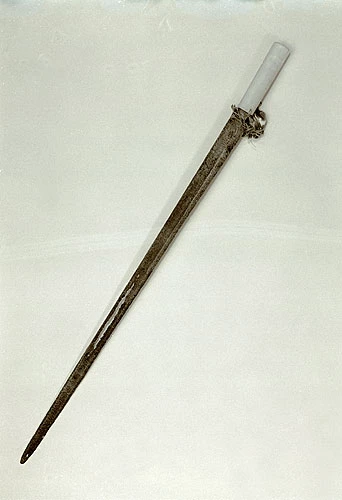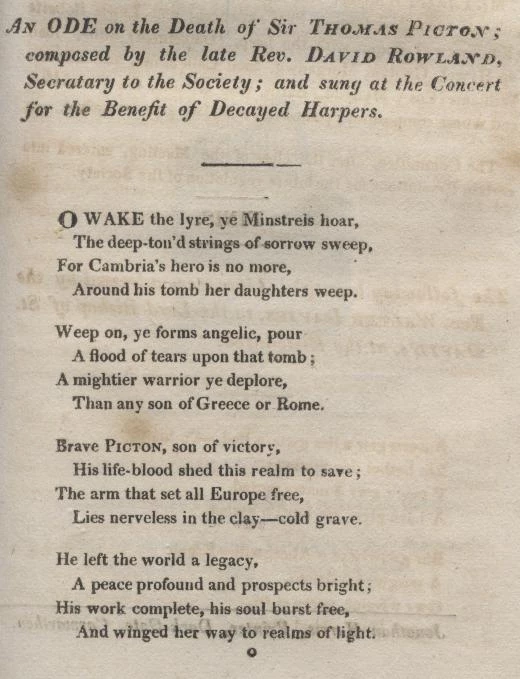Pebbles and plots: eisteddfodau after the Napoleonic Wars
From Revolution to Reverends
The Napoleonic wars [1803-1815] led to a hiatus in the Gwyneddigion’s eisteddfodic activities. The radicalism of many London Welshmen had made the authorities profoundly uneasy, and a number of prominent Welshmen who had links to the Gwyneddigion – among them Dr Richard Price and John Jones (Jac Glan Gors) — had been deeply interested in the Revolution in France. Indeed, the authorities had instigated a raid on the Caradogion, the Gwyneddigion’s sister society. When Iolo Morganwg (Edward Williams, 1747-1826) created the Gorsedd of Bards (Gorsedd Beirdd Ynys Prydein) in 1792 its possibly seditious connections were viewed with suspicion.
When the war came to an end these eisteddfodic interests resumed and many began to think seriously about creating proper Eisteddfodau. These ambitions were embraced most warmly by a group of clergymen under the leadership of Ifor Ceri (The Reverend John Jenkins, 1770-1829). He became known as one of the hen bersoniaid llengar (‘old literary clerics’), Anglican clergymen who delighted in the language and culture of Wales, and it was men such as he who took a deep interest in the first regional Eisteddfod, in Carmarthen in 1819.
The Gwyneddigion Society medal awarded at the Bala Eisteddfod, 1789. The medal was designed by Augustus Duprê, General Engraver of French Money to the National Assembly of France. Considering 1789 was the year of the French Revolution, this was a very notable art commission.
Iolo Morganwg's sword, used in the 1819 ceremony.
Iolo brings his stones and sword
The 1819 Carmarthen Eisteddfod was remarkable for being the first of ten regional Eisteddfodau which transformed the movement's history. One of the main reasons for this was the Gorsedd. Although held for the first time on 21 June 1792, on Primrose Hill in London, there was no link between the Gorsedd and the Eisteddfod until Iolo Morganwg saw his chance at Carmarthen in 1819.
Aged seventy, he travelled all the way from Merthyr where he was staying at the time. On arriving at Carmarthen, he created a Gorsedd circle on the lawn of the Ivy Bush Hotel with a handful of pebbles from his pockets. He went on to admit poets and druids, giving them white, blue and green ribbons according to their rank. During the chairing ceremony a new rite took form as poets stood either side of the chair, sheathing and unsheathing a sword above the winning poet’s head. The sword used by Iolo Morganwg during the 1819 ceremonies is still to be seen at St Fagans National History Museum.
An ode to a hero of Waterloo
Gwallter Mechain (another of the hen bersoniaid llengar) was still competing and winning prizes. At the Carmarthen Eisteddfod he won the chair for his elegy to Carmarthen's idol, Sir Thomas Picton, hero of Waterloo. The prize was a silver medal with an engraving of the chair, made by the artist Hugh Hughes (newly returned to Wales from London, he had connections with a number of figures in the Eisteddfod movement). Medals such as these speak eloquently of the status and dignity the Welsh sought for their culture on the virtual stage offered by the Eisteddfod.
The silver medal won by Gwallter Mechain at the Carmarthen Eisteddfod, 1819.
Concert for the benefit of decayed harpists, Carmarthen 1819
Anglo-Italian farce
With time the regional Eisteddfodau became extremely fashionable events — events where two cultures, the Welsh–language and the Anglicised, came face to face. The venerable traditional poets who had long thought themselves keepers of the Eisteddfod flame felt bitter at being left on the sidelines. Indeed, Ifor Ceri called these events an ‘Anglo-Italian farce’, because of the artistes brought down from London to perform at the Eisteddfod — in English.
This Anglicised, concert-hall vision of culture went head to head with traditional Welsh language culture at Carmarthen in 1819 when the Reverend John Bowen brought a choir to the Eisteddfod. These members of the Bath Harmonic Society held two benefit concerts, one for the widows and orphans of deceased clergymen and the other in aid of so-called "decayed harpists" who had become too enfeebled to support themselves. The bourgeoisie of Carmarthen flocked to these fashionable concerts. From this moment onwards the battle between the two cultures for the soul of the Eisteddfod had begun.

